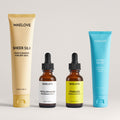
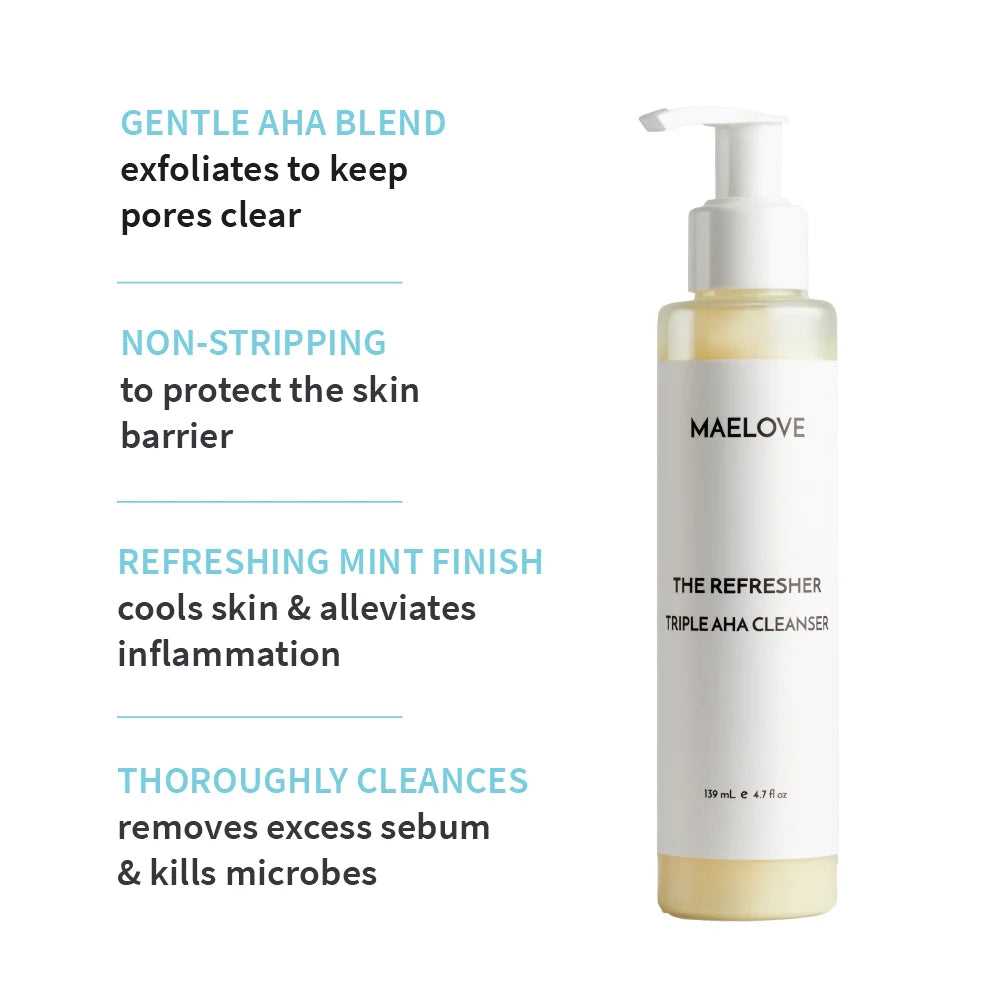
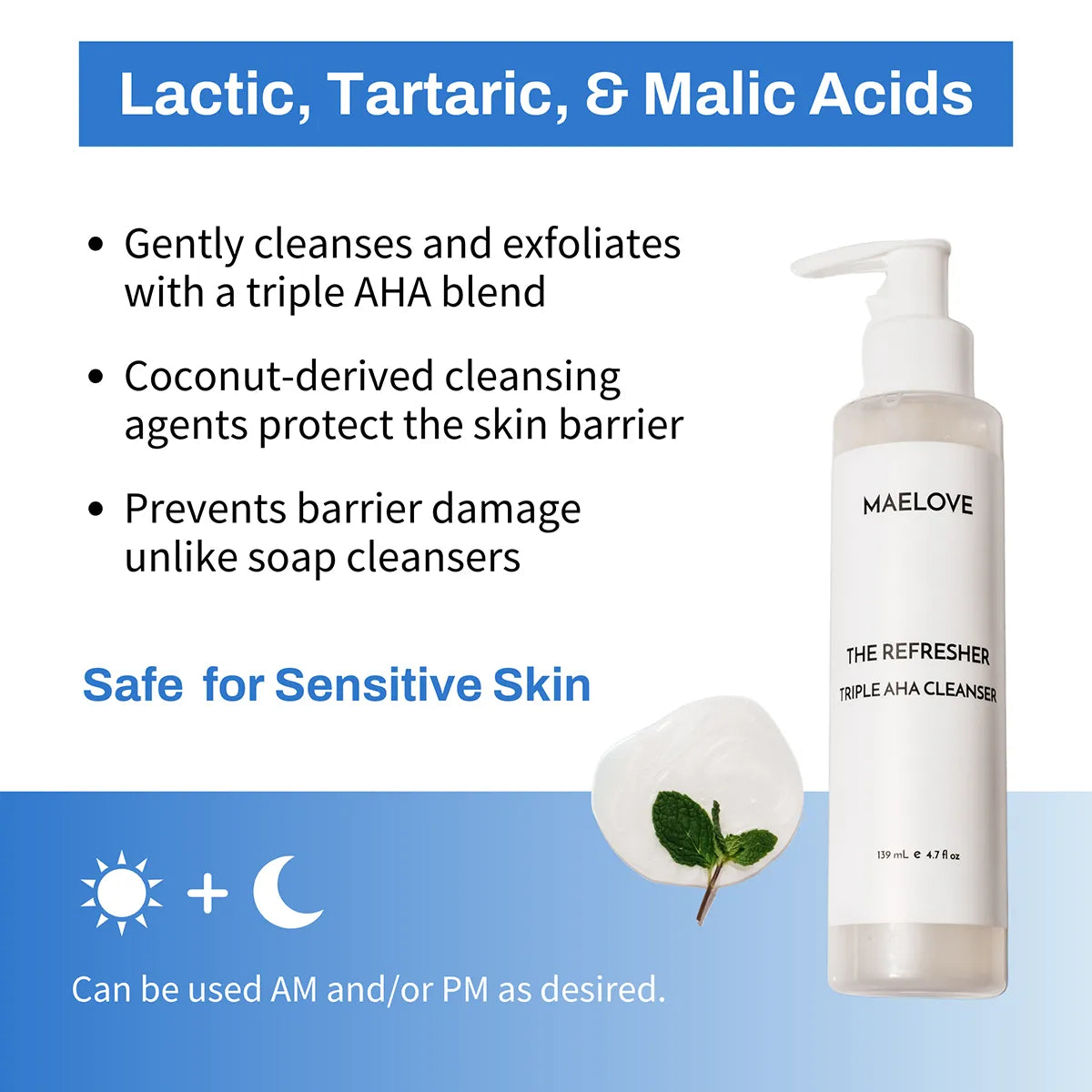
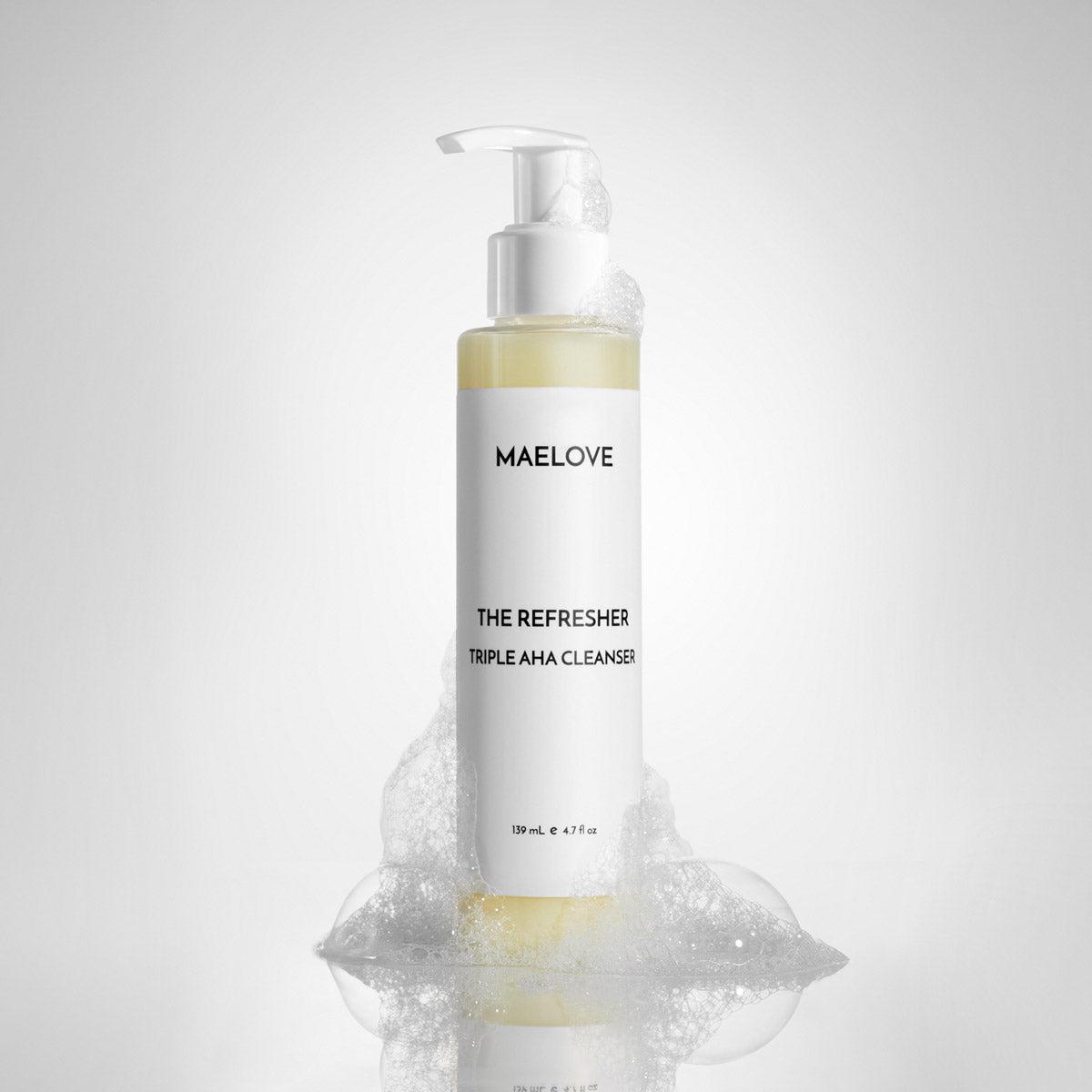
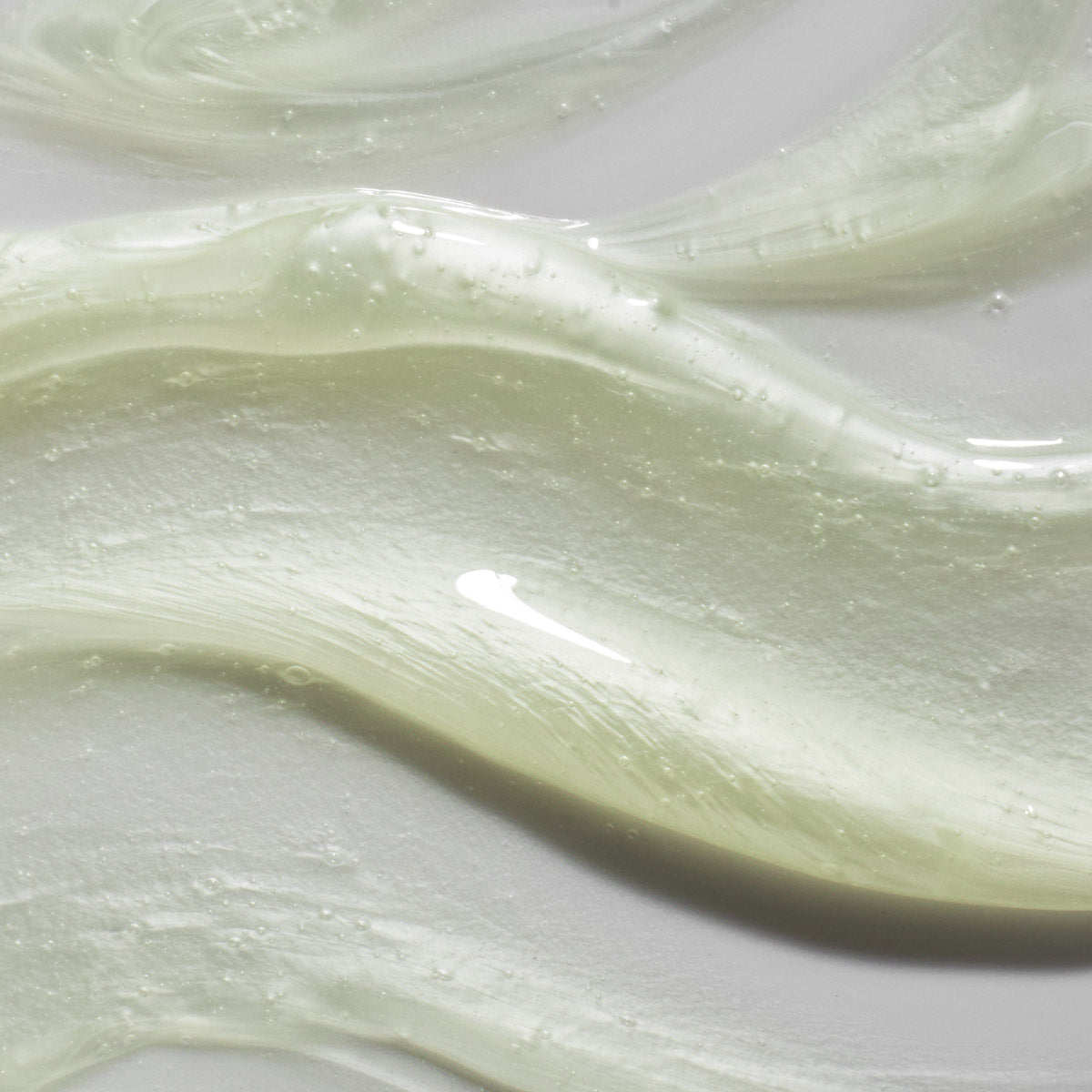

1100+ purchased in the last 30 days
The Refresher AHA Clarifying Cleanser
- Cleanses without stripping
- Unclogs pores
- Gently exfoliates
- Lactic acid
- Tartaric acid
- Malic acid

OBSESSIVELY FORMULATED
The Refresher uses a triple blend of alpha hydroxy acids (AHAs) including lactic, malic, and tartaric acids, combined with mild, coconut-derived cleansing agents to provide both exfoliation and cleansing without harming the skin barrier.
This invigorating cleanser contains organic mint for a refreshing finish. Naturally anti-inflammatory, this infusion provides a cooling sensation to help alleviate inflamed skin.
Our gentle formula is non-stripping and can be used by all skin types without disrupting your skin's natural sebum layer. Plus, it is helpful in managing breakouts for those who are acne-prone.
Gentle cleansing combined with AHA exfoliation
- Features a triple blend of AHAs (lactic, malic, and tartaric acid) to gently exfoliate
- A blend of mild and gentle coconut-derived cleansing agents that do not harm the skin barrier
- Acidic cleansing prevents alkaline damage to the skin barrier unlike soap cleansers
For AM and/or PM. Wet face and gently massage onto skin using circular motions. Avoid contact with the eyes. Wash off thoroughly with water.
See our How to Layer guide for tips on layering multiple Maelove products.
Key Ingredients
Lactic acid, tartaric acid, malic acid
Supporting Ingredients
Sodium C14-16 olefin sulfonate, sodium cocoamphoacetate, cocamidopropyl hydroxysultaine
All Maelove products are safe for sensitive skin, made in the US, vegan, cruelty-free, non-comedogenic, gluten-free, and free of parabens, phthalates, dyes, and artificial fragrances. We don't use ingredients that are banned in the EU or in the USA.
Show all ingredients
Customer Reviews
For the Curious
While soaps with their high pH are the worst culprits and should be avoided altogether in skin cleansing, synthetic detergents (syndets) vary widely in their level of disruptiveness to the skin barrier. Syndets such as sulfates sodium lauryl sulfate (SLS) also known as sodium dodecyl sulfate (SDS) and sodium lauryl ether sulfate (SLES), are known to be irritating and harsh on the skin with the added downside of being harmful to the environment.
Modern high-quality cleansers rely instead on milder detergents that are better for the environment, as well as detergent blends that combine anionic and amphoteric surfactants which cleanse with minimal interaction with the skin barrier (Ananthapadmanabhan et al. 2004, Ananthapadmanabhan 2019, Coiffard and Couteau 2020, Mijaljica et al. 2022).
The Refresher Clarifying Cleanser employs this modern approach to skin cleansing using a blend of three mild and environmentally friendly, coconut oil derived syndets: Sodium C14-16 Olefin Sulfonate, Sodium Cocoamphoacetate, and Cocamidopropyl Hydroxysultaine
Skin cleansing is particularly important for those with oily or combination skin that is sensitive and acne-prone. At least one study that looked at the frequency of face washing in patients with acne found that patients who washed their face twice a day had significant improvements while those washing only once a day had worsening acne, and those washing four times a day had no change (Choi et al. 2006). The American Academy of Dermatologists also supports the common advice of washing your face twice a day, once in the morning and once in the evening, is ideal for acne prone skin.
Equally important to the frequency of cleansing however, is the choice of cleanser. Indeed, when soaps are compared to synthetic detergents (syndets) as a cleanser in adolescents and young adults with acne-prone skin, inflammatory lesions increased from baseline in those who used soap. However, it decreased in the group who used an acidic syndet bar. In other words, cleansing with alkaline soap could make acne worse but cleansing with an acidic syndet could make acne better (Korting et al. 1995). Further, for those with specialized problem such as acne, acne-specific cleansers with hydroxy acids did a superior job at decreasing inflammatory acne lesions long-term than a regular cleanser (Choi et al. 2010). The Refresher Clarifying Cleanser contains a triple blend of alpha hydroxy acids (lactic, malic, and tartaric acid) as well as gentle coconut-based syndets to safely cleanse skin.
Yes! Glycolic acid and other alpha hydroxy acids (AHAs) have been tested in animals and showed no teratogenic effects (Chien et al. 2016, Putra et al. 2022). AHAs are only absorbed through the skin and into the bloodstream in negligible amounts and are considered safe in pregnancy at the levels used in over the counter products (Bozzo et al. 2011, Putra et al. 2022). However, it is always advisable to check with your doctor regarding skincare products and ingredients and follow their protocol.
Ananthapadmanabhan KP, Moore DJ, Subramanyan K, Manoj M, Meyer F (2004). “Cleansing without compromise: the impact of cleansers on the skin barrier and the technology of mild cleansing.” Dermatologic Therapy 17: 16-25.
Ananthapadmanabhan KP (2019). “Amino-Acid Surfactants in Personal Cleansing (Review).” Tenside Surf Det 56(5): 378-386.
Coiffard L, Couteau C (2020). “Soap and syndets: differences and analogies, sources of great confusion.” Eu Rev Med Pharmacol Sci 24: 11432-11439.
Mijaljica D, Spada F, Harrison IP (2022). “Skin Cleansing without or with Compromise: Soaps and Syndets.” Molecules 27: https://doi.org/10.3390/molecules27062010.
Choi JM, Lew VK, Kimball AB (2006). “A single-blinded, randomized, controlled clinical trial evaluating the effect of face washing on acne vulgaris.” Pediatr Dermatol 23(5): 421-427.
Choi YS, Suh HS, Yoon MY, Min SU, Kim JS, Jung JY, Lee DH, Suh DH (2010). “A study of the efficacy of cleansers for acne vulgaris.” J Dermatolog Treat 21(3): 201-205.
Korting HC, Ponce-Poschl E, Klovekorn W, Schmotzer G, Arens-Corell M, Braun-Falco O (1995). “The influence of the regular use of a soap or an acidic syndet bar on pre-acne.” Infection 23(2): 89-93.
Bozzo P, Chua-Gocheco A, Einarson A (2011). “Safety of skin care products during pregnancy.” Canadian Family Physician 57: 665-667.
Chien AL, Rainer B, Sachs DL, Helfrich YR (2016). “Treatment of Acne in Pregnancy.” J Am Board Fam Med. 29: 254-262.
Putra IB, Jusuf NK, Dewi NK (2022). “Skin Changes and Safety Profile of Topical Products During Pregnancy.” J Clin Aesthet Dermatol. 15(2): 49-57.

